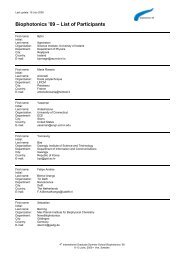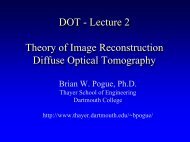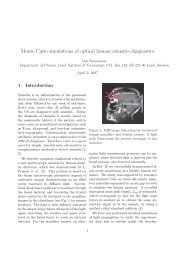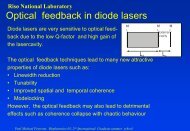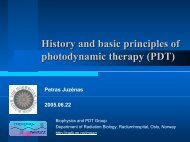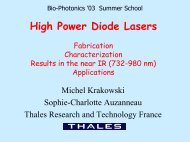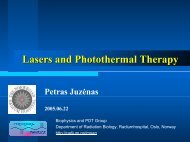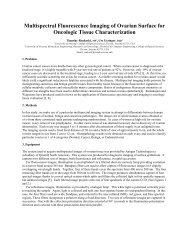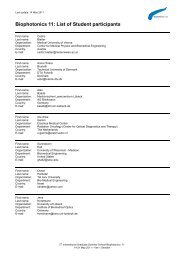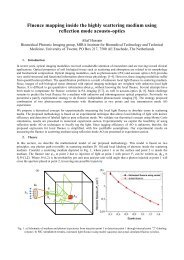Laser diodes with phase conjugate feedback
Laser diodes with phase conjugate feedback
Laser diodes with phase conjugate feedback
You also want an ePaper? Increase the reach of your titles
YUMPU automatically turns print PDFs into web optimized ePapers that Google loves.
Risø National Laboratory<br />
<strong>Laser</strong> <strong>diodes</strong> <strong>with</strong> <strong>phase</strong> <strong>conjugate</strong> <strong>feedback</strong><br />
Paul M. Petersen<br />
Risø National Laboratory, Denmark<br />
Paul Michael Petersen, <strong>Laser</strong> Diodes <strong>with</strong> External Feedback (tutorial)
Risø National Laboratory<br />
Generation of <strong>phase</strong> <strong>conjugate</strong> waves<br />
A 4<br />
A 1<br />
Nonlinear<br />
medium χ (3)<br />
A 2<br />
A 3<br />
The classic configuration for four-wave mixing<br />
The interaction between the three waves A 1 , A 2 and A 3 inside<br />
the nonlinear medium leads to the generation of a <strong>phase</strong> <strong>conjugate</strong><br />
beam A 3 propagating exactly counteropposed to A 4<br />
Paul Michael Petersen, <strong>Laser</strong> Diodes <strong>with</strong> External Feedback (tutorial)
Risø National Laboratory<br />
Phase aberration correcting properties of<br />
<strong>phase</strong> <strong>conjugate</strong> waves<br />
original distorted corrected<br />
• Corrects for <strong>phase</strong> aberrations inside the laser cavity<br />
• Output beam of laser cavity close to the diffraction limit<br />
Paul Michael Petersen, <strong>Laser</strong> Diodes <strong>with</strong> External Feedback (tutorial)
Risø National Laboratory<br />
Phase <strong>conjugate</strong> mirrors<br />
normal mirror <strong>phase</strong> <strong>conjugate</strong> mirror<br />
The autoretracing property of <strong>phase</strong> <strong>conjugate</strong> mirrors<br />
is important for the basic understanding of how these<br />
mirrors work in laser cavities<br />
Paul Michael Petersen, <strong>Laser</strong> Diodes <strong>with</strong> External Feedback (tutorial)
Risø National Laboratory<br />
High-power laser diode arrays<br />
proton implantation<br />
metallization<br />
GaAs (p-type)<br />
GaAlAs (p-type)<br />
GaAlAs<br />
GaAlAs (n-type)<br />
GaAs (n-type)<br />
gain<br />
High output power (>50 W)<br />
Long lifetimes (>30.000 h)<br />
Very poor spatial and temporal coherence<br />
Paul Michael Petersen, <strong>Laser</strong> Diodes <strong>with</strong> External Feedback (tutorial)
Risø National Laboratory<br />
Optical <strong>phase</strong> conjugation using<br />
photorefractive materials<br />
BaTiO 3<br />
crystals<br />
Self-pumped <strong>phase</strong> conjugation<br />
using photorefractive materials<br />
•Self-organizing process leads to optical <strong>phase</strong> conjugation<br />
•No external pump beams are needed<br />
•High reflectivities (> 90 %) even at low optical power levels<br />
Paul Michael Petersen, <strong>Laser</strong> Diodes <strong>with</strong> External Feedback (tutorial)
Risø National Laboratory<br />
Improvement of the coherence properties<br />
of laser diode arrays<br />
Method: <strong>phase</strong> <strong>conjugate</strong> <strong>feedback</strong><br />
-effective coupling of the laser elements<br />
-self starting <strong>feedback</strong> configuration<br />
-at high output power instabilities take place<br />
Paul Michael Petersen, <strong>Laser</strong> Diodes <strong>with</strong> External Feedback (tutorial)
Risø National Laboratory<br />
Phase <strong>conjugate</strong> <strong>feedback</strong><br />
Løbel et al., Optics Lett. 23, 825 (1998)<br />
Frequency selective <strong>phase</strong> <strong>conjugate</strong> <strong>feedback</strong><br />
eliminates instabilities<br />
Paul Michael Petersen, <strong>Laser</strong> Diodes <strong>with</strong> External Feedback (tutorial)<br />
.
Risø National Laboratory<br />
Single-mode operation<br />
Intensity [arb.]<br />
FWHM=0.02 nm<br />
(10 GHz)<br />
PC-Feedback<br />
Freely run.<br />
0.63<br />
nm<br />
0.63<br />
nm<br />
810 811 812 813 814 815 816 817<br />
Wavelength [nm]<br />
100 µm<br />
Paul Michael Petersen, <strong>Laser</strong> Diodes <strong>with</strong> External Feedback (tutorial)
Risø National Laboratory<br />
Asymmetric <strong>phase</strong> <strong>conjugate</strong> <strong>feedback</strong><br />
Single-lobe configuration<br />
Paul Michael Petersen, <strong>Laser</strong> Diodes <strong>with</strong> External Feedback (tutorial)
Risø National Laboratory<br />
Far-field<br />
output<br />
Diffraction<br />
limited output<br />
<strong>with</strong> singlelobe<br />
config.<br />
Intensity [arb. units]<br />
0<br />
0<br />
0<br />
1.4 times the<br />
diffraction limit<br />
-5 -4 -3 -2 -1 0 1 2 3 4 5<br />
Radiation angle [deg]<br />
Single-lobe<br />
Twin-lobe<br />
Runs freely<br />
Paul Michael Petersen, <strong>Laser</strong> Diodes <strong>with</strong> External Feedback (tutorial)
Risø National Laboratory<br />
Etalon setup<br />
Coherence degree γ<br />
1,0<br />
0,9<br />
0,8<br />
0,7<br />
0,6<br />
0,5<br />
0,4<br />
0,3<br />
0,2<br />
0,1<br />
Array runs freely (2I th )<br />
Feedback applied (2I th )<br />
Feedback applied (3I th )<br />
Output sent<br />
to Michelson<br />
interferometer<br />
Coherence<br />
length is<br />
increased<br />
several orders<br />
of magnitude<br />
0,1 1 10 100<br />
Path difference [mm]<br />
Paul Michael Petersen, <strong>Laser</strong> Diodes <strong>with</strong> External Feedback (tutorial)<br />
.
Risø National Laboratory<br />
Grating configuration<br />
Phase <strong>conjugate</strong><br />
<strong>feedback</strong> only applied<br />
to one of two far-field<br />
lobes.<br />
Paul Michael Petersen, <strong>Laser</strong> Diodes <strong>with</strong> External Feedback (tutorial)
Risø National Laboratory<br />
Singlemode<br />
(a)<br />
Single-mode<br />
operation<br />
BW < 0.03 nm<br />
Wavelength<br />
is tunable<br />
over 20 nm !<br />
Intensity [arbitrary units]<br />
807 808 809 810 811 812 813 814<br />
Wavelength [nm]<br />
(b)<br />
(c)<br />
(d)<br />
(e)<br />
Paul Michael Petersen, <strong>Laser</strong> Diodes <strong>with</strong> External Feedback (tutorial)
Risø National Laboratory<br />
Optical <strong>phase</strong> conjugation using<br />
semiconductor lasers<br />
P. Kürz, R. Nagar, and T. Mukai, Appl.<br />
Phys. Lett. 68, pp.1180-1182, 1996<br />
•Highly efficient <strong>phase</strong> conjugation is obtained (R>>100 %)<br />
•May be used for frequency stabilization of semiconductor<br />
lasers in external <strong>feedback</strong> configurations<br />
Paul Michael Petersen, <strong>Laser</strong> Diodes <strong>with</strong> External Feedback (tutorial)
Risø National Laboratory<br />
Four-wave mixing operation in high power <strong>diodes</strong><br />
0<br />
L<br />
The nonlinear polarization is given by P=<br />
ε χ( N)<br />
E<br />
nc<br />
where χ( N) =− ( β+i)g(N) , g(N)=a(N-N<br />
0)<br />
ω<br />
Z<br />
R=R 1 Z=0<br />
R=0<br />
Gain and refractive<br />
index gratings<br />
A 1<br />
A 3<br />
Semiconductor<br />
amplifier<br />
A 2<br />
Electrode<br />
0<br />
Z=L<br />
dA1<br />
* *<br />
=−α0A1− γ( AA<br />
1 4<br />
+ A2A3) A4<br />
(1A)<br />
dz<br />
*<br />
dA2<br />
* * * *<br />
=+ α0A2 − γ( AA<br />
1 4<br />
+ A2A3) A3<br />
(1B)<br />
dz<br />
dA3<br />
* *<br />
=+ α0A3+ γ( AA<br />
1 4<br />
+ A2A3) A2<br />
(1C)<br />
dz<br />
*<br />
dA4<br />
* * * *<br />
=− α0A4 + γ( AA<br />
1 4<br />
+ A2A3) A1<br />
(1D)<br />
dz<br />
(1 − iβ<br />
) g0<br />
α0<br />
=− is the effective gain<br />
2(1 + P )<br />
P<br />
0<br />
=<br />
E<br />
0<br />
P<br />
s<br />
2<br />
0<br />
0<br />
is the average intercavity pump intensity<br />
2C<br />
γ=-i α0<br />
is the coupling factor<br />
1+<br />
P<br />
Paul Michael Petersen, <strong>Laser</strong> Diodes <strong>with</strong> External Feedback (tutorial)
Risø National Laboratory<br />
DFWM in <strong>diodes</strong> using total internal reflection<br />
0<br />
Gain and refractive<br />
index gratings<br />
A 1<br />
High reflective<br />
coating<br />
Z=0<br />
Semiconductor<br />
amplifier<br />
Electrode<br />
L<br />
Z<br />
A 3<br />
A 2<br />
Z=L<br />
Antireflection<br />
coating<br />
Spatial- and temporal<br />
filtering<br />
Output<br />
beam<br />
M<br />
Paul Michael Petersen, <strong>Laser</strong> Diodes <strong>with</strong> External Feedback (tutorial)
Risø National Laboratory<br />
Generation of carriers is governed by the rate Equation:<br />
dN I N 2<br />
= − + D ∇ N − g ( N ) E<br />
0<br />
dt qV τ<br />
s<br />
(1)<br />
where N(x,y,z) is the excited carrier population,<br />
s<br />
is the carrier recombination time,I is the injected current<br />
D the ambipolar diffusivity, E 0 is the total optical field<br />
g(N)=a(N-N 0 ) is the gain.<br />
Assuming that:<br />
N = N +∆nexp( i∆ky)<br />
(2)<br />
We find that the third order susceptibility is given by:<br />
χ<br />
FWM<br />
⎛<br />
⎞<br />
⎜<br />
⎟<br />
χ<br />
FWM ,max<br />
1<br />
=<br />
⎜<br />
⎟<br />
2 2<br />
E ⎜ IkD<br />
0<br />
s<br />
τ ⎟<br />
s 2<br />
1+ 1+<br />
2 θ<br />
I ⎜ I<br />
s<br />
s<br />
E ⎟<br />
⎝ +<br />
0 ⎠<br />
2<br />
(3)<br />
Paul Michael Petersen, <strong>Laser</strong> Diodes <strong>with</strong> External Feedback (tutorial)
Risø National Laboratory<br />
The nonlinear susceptibility χ (3)<br />
χ (3)<br />
The third order nonlinear susceptibility versus the angle [in units of 1/( k(D<br />
a<br />
<br />
R<br />
)-½)]<br />
<br />
The nonlinear susceptibility is reduced to half the maximum at an angle<br />
corresponding to:<br />
2<br />
E0<br />
1+<br />
1 Is<br />
θ½<br />
=<br />
k Dτ<br />
Paul Michael Petersen, <strong>Laser</strong> Diodes <strong>with</strong> External Feedback (tutorial)<br />
s
Risø National Laboratory<br />
The mode suppression factor<br />
0<br />
Z=0<br />
Semiconductor<br />
amplifier<br />
Electrode<br />
L<br />
Z<br />
Z=L<br />
The output beam is a result of diffraction in the induced gratings inside<br />
the semiconductor amplifier. The diffraction angle ’ inside the<br />
semiconductor is given by: sin θ’ = λ/(Λn). For small angles the <strong>phase</strong><br />
difference between a wave diffracted at the front facet and the back facet<br />
of the amplifier is given by:<br />
δ = 2πnL/λ -2πnLcos θ’/λ = 2πn(1-cosθ’)/λ<br />
Since 1-cosθ’= 2sin 2 (θ’/2) and n sin’ = sin we obtain:<br />
4π<br />
L<br />
δ = Sin<br />
λn<br />
2<br />
θ<br />
2<br />
Paul Michael Petersen, <strong>Laser</strong> Diodes <strong>with</strong> External Feedback (tutorial)
Risø National Laboratory<br />
The mode suppression factor<br />
8<br />
The mode suppression factor δ<br />
6<br />
4<br />
2<br />
1 2 3 4 5<br />
<br />
The mode suppression factor δ of the induce<br />
grating versus the angle between the interfering<br />
laser beams in the four-wave interaction (L=1 mm,<br />
n=3.4, •=810 nm)<br />
In practice the factor must be somewhat larger 2 π to have effectively<br />
suppression of different axial modes in the broad area amplifier.<br />
The critical angle for which mode suppression occurs depends on the length of<br />
the amplifier and is determined by :<br />
θ =<br />
crit<br />
nλ<br />
2Arcsin( )<br />
2L<br />
Paul Michael Petersen, <strong>Laser</strong> Diodes <strong>with</strong> External Feedback (tutorial)
Risø National Laboratory<br />
Fundamental condition for laser action<br />
In general, the laser system needs mode suppression from the<br />
gratings and a large nonlinear susceptibility. This condition leads to<br />
the condition that the angle must be chosen according to:<br />
E0<br />
1+<br />
⎛ nλ<br />
⎞ 1 Is<br />
2arcsin<br />
⎜<br />
θ<br />
2L ⎟ < <<br />
⎝ ⎠ k Dτ<br />
s<br />
2<br />
Paul Michael Petersen, <strong>Laser</strong> Diodes <strong>with</strong> External Feedback (tutorial)
Risø National Laboratory<br />
Nonlinear gratings and mode suppression<br />
(Numerical example)<br />
Mode suppression<br />
Inserting L=1 mm, n=3.4, •=810 nm for GaAlAs we<br />
obtain crit<br />
= 4.2<br />
Nonlinear gratings<br />
For GaAlAs the parameters are D a<br />
=13cm 2 /s and R<br />
=1<br />
ns and consequently we obtain at 810 nm ½<br />
= 6.5<br />
Mode suppression and strong gratings are obtained<br />
when 4.2 < < 6.5°<br />
Paul Michael Petersen, <strong>Laser</strong> Diodes <strong>with</strong> External Feedback (tutorial)
Dynfrac amic tivein dexg gain andre rating -s<br />
A1<br />
Sem icond uctor<br />
E lectro<br />
amp lifier<br />
A3 A2<br />
O utpu t<br />
b eam<br />
Risø National Laboratory<br />
Monolithic dynamic grating laser<br />
Permanent grating<br />
A 1<br />
Dynamic gain and refractive<br />
index gratings<br />
Semiconductor<br />
amplifier<br />
A 3<br />
A 2<br />
Electrode<br />
Output<br />
beam<br />
Paul Michael Petersen, <strong>Laser</strong> Diodes <strong>with</strong> External Feedback (tutorial)



